Flower beds can transform a garden into a vibrant oasis, but when overrun by weeds, they become an eyesore and a headache for gardeners. In this comprehensive guide, we’ll explore effective strategies for reclaiming your flower beds from full weeds and maintaining a weed-free garden sanctuary.
| Takeaways |
|---|
| Effective weed removal requires a systematic approach, including assessment, preparation, execution, and maintenance. |
| Understanding the types of weeds present in your flower beds and conducting soil analysis are crucial steps in the weed removal process. |
| Manual removal, chemical treatments, and organic remedies offer diverse options for weed eradication, each with its own benefits and considerations. |
| Preventive measures such as mulching, proper spacing of plants, and regular maintenance are essential for inhibiting weed regrowth in flower beds. |
| Selecting low-maintenance plants suited to your garden environment and following proper planting techniques can contribute to long-term weed control and garden success. |
2. Assessing the Situation
Understanding the Weed Types
Before diving into weed removal methods, it’s crucial to identify the types of weeds infesting your flower beds. Common weeds include broadleaf, grassy, and perennial varieties, each requiring different eradication approaches.
When troubleshooting your garden, consider What to Do When Your Tertill Weeding Robot Stops Working. Sometimes, simple fixes can save the day, ensuring your garden stays weed-free effortlessly.
Table: Types of Weeds and Identification
| Weed Type | Characteristics | Common Examples |
|---|---|---|
| Broadleaf | Broad leaves, taproots | Dandelion, Plantain |
| Grassy | Narrow leaves, fibrous roots | Crabgrass, Bermuda Grass |
| Perennial | Deep roots, persistent growth | Bindweed, Thistle |
Soil Analysis
Performing a soil analysis helps determine the underlying issues contributing to weed growth. Factors such as pH levels, nutrient deficiencies, and soil compaction can affect plant health and weed proliferation.
Table: Soil Analysis Parameters
| Parameter | Ideal Range | Action Needed |
|---|---|---|
| pH Level | 6.0-7.0 | Lime for acidity, sulfur for alkalinity |
| Nutrient Levels | Balanced NPK ratios | Organic fertilizers, compost |
| Soil Texture | Loamy | Organic matter, soil amendments |
3. Preparing for Weed Removal

Essential Tools and Equipment
Gathering the right tools is essential for efficient weed removal. Here’s a list of equipment you’ll need:
- Hand Trowel: Ideal for digging out individual weeds, especially in tight spaces.
- Garden Fork: Useful for loosening compacted soil and extracting deep-rooted weeds.
- Weeding Knife: Perfect for cutting through stubborn weeds and their roots.
- Garden Hoe: Effective for cultivating soil and uprooting surface-level weeds.
- Safety Gloves: Protect your hands from thorns, prickles, and potential chemical exposure.
- Protective Eyewear: Shield your eyes from debris when using tools or chemicals.
Choosing the right weed killer is crucial for maintaining a healthy garden. Learn more about What Kind of Weed Killer Can You Use in Flower Beds? to keep your flower beds flourishing.
Safety Precautions
While tackling weed removal, prioritize safety to prevent injuries and exposure to harmful substances:
- Wear long sleeves, pants, and closed-toe shoes to protect your skin from scratches and irritants.
- Use gloves when handling tools, chemicals, or organic remedies to avoid skin contact.
- Keep children and pets away from the work area, especially when using chemical treatments.
- Follow manufacturer instructions carefully when using herbicides or pesticides, and avoid overspraying onto desired plants.
Ensuring your safety and the safety of others should always be the top priority when dealing with weed removal tasks.
4. Methods for Weed Removal
Once you’ve assessed the weed types and prepared the necessary tools, it’s time to tackle the weed infestation in your flower beds. Here are several effective methods for weed removal:
Manual Removal
Manual weed removal involves physically pulling out weeds by hand or using handheld tools. While labor-intensive, this method is eco-friendly and allows for precise targeting of weeds without harming surrounding plants.
Table: Pros and Cons of Manual Weed Removal
| Method | Pros | Cons |
|---|---|---|
| Hand Pulling | – Environmentally friendly | – Labor-intensive |
| – Precise removal of weeds and roots | – Time-consuming | |
| Weeding Tools | – Increased leverage and efficiency | – Limited effectiveness on deep-rooted weeds |
| – Targeted removal in tight spaces | – Risk of soil disturbance and plant damage |
Chemical Treatments
Chemical herbicides offer a potent solution for controlling weeds, but they should be used with caution and according to label instructions to minimize environmental impact and ensure safety.
Table: Common Chemical Herbicides for Weed Control
| Herbicide | Active Ingredient | Target Weeds | Application |
|---|---|---|---|
| Glyphosate | Glyphosate | Broad-spectrum | Direct application |
| (non-selective) | |||
| 2,4-D | 2,4-Dichlorophenoxyacetic acid | Broadleaf | Spot treatment |
| or broadcast spray |
Organic Remedies
For those preferring natural alternatives, several organic remedies effectively suppress weed growth while nourishing soil and promoting overall garden health.
Planning to enhance your flower beds with pavers? Follow these steps on How Do You Lay Pavers in Flower Beds? for a professional and polished look.
Table: Natural Weed Control Methods
| Method | Description | Effectiveness |
|---|---|---|
| Mulching | Covering soil with organic materials | High |
| (e.g., wood chips, straw) to suppress | ||
| weed germination and growth | ||
| Vinegar Solution | Spraying undiluted vinegar on weeds | Moderate to high |
| to desiccate and kill them |
By employing a combination of these methods, you can effectively eradicate weeds from your flower beds and restore their beauty and vitality.
5. Preventing Weed Regrowth
After successfully removing weeds from your flower beds, it’s essential to implement preventive measures to inhibit their return. Here are some strategies for preventing weed regrowth:
Mulching Techniques
Mulching is one of the most effective methods for suppressing weed growth by creating a barrier that blocks sunlight and prevents weed seeds from germinating. Organic mulches, such as wood chips, straw, or compost, not only inhibit weeds but also improve soil health and moisture retention.
Table: Types of Mulch and Their Benefits
| Mulch Type | Description | Benefits |
|---|---|---|
| Wood Chips | Shredded bark or wood pieces | Long-lasting |
| Suppresses weed growth | ||
| Straw | Dried stalks of grain plants | Biodegradable |
| Adds organic matter to soil | ||
| Compost | Decomposed organic matter | Enriches soil with nutrients |
| Suppresses weeds naturally |
Soil Amendments
Improving soil health can help create unfavorable conditions for weed growth while promoting the vigor of desirable plants. Incorporating organic amendments and practicing proper soil management techniques can enhance soil structure, fertility, and microbial activity.
Cat owners know the struggle of keeping their feline friends out of flower beds. Discover effective methods outlined in How to Keep Cats Out of Your Flower Beds to protect your blooms.
Table: Soil Amendments for Weed Prevention
| Amendment | Description | Benefits |
|---|---|---|
| Compost | Decomposed organic matter | Enriches soil with nutrients |
| Improves soil structure | ||
| Cover Crops | Crops grown specifically to improve soil | Suppresses weeds |
| health and fertility | Prevents soil erosion | |
| Green Manure | Fresh plant material incorporated into soil | Adds organic matter |
| Suppresses weed growth |
Implementing these preventive measures alongside regular maintenance will help keep your flower beds free from weeds and promote the health and beauty of your garden.
Shall we continue with exploring options for replanting your flower beds with low-maintenance plants?
6. Replanting Options

Once you’ve cleared your flower beds of weeds and implemented preventive measures, it’s time to consider replanting with low-maintenance plants that will thrive in your garden environment. Here are some factors to consider when selecting plants and tips for proper planting:
Selecting Low-Maintenance Plants
Choosing the right plants can make a significant difference in the maintenance requirements of your flower beds. Opt for species that are resilient, disease-resistant, and well-suited to your climate and soil conditions. Here are some examples of low-maintenance plants:
Table: Low-Maintenance Plants for Flower Beds
| Plant Type | Characteristics | Examples |
|---|---|---|
| Perennials | Long-lived, return year after year | Daylilies, Sedum, Hostas |
| Low water and maintenance requirements | ||
| Native Plants | Adapted to local climate and soil | Coneflower, Black-eyed Susan |
| Attract native pollinators | ||
| Ground Covers | Spreading plants that suppress weeds | Creeping Thyme, Vinca Minor |
| Provide erosion control |
Proper Planting Techniques
To ensure the success of your new plantings, follow these planting guidelines:
- Prepare the Soil: Loosen the soil and amend with compost or organic matter to improve fertility and drainage.
- Spacing: Plant according to the recommended spacing for each species to allow for proper growth and airflow.
- Planting Depth: Dig holes slightly larger than the root ball and plant at the same depth as the container or nursery pot.
- Watering: Water newly planted flowers thoroughly to settle the soil and encourage root establishment.
- Mulching: Apply a layer of mulch around newly planted flowers to conserve moisture, suppress weeds, and regulate soil temperature.
By selecting low-maintenance plants and following proper planting techniques, you can create a beautiful and hassle-free garden that brings joy year after year.
Ready to explore tips for maintaining weed-free flower beds?
7. Maintenance Tips for Weed-Free Flower Beds

Maintaining weed-free flower beds requires ongoing effort and attention to detail. Here are some essential tips to help you keep your garden beds pristine:
Regular Inspection
Frequent inspection of your flower beds allows you to identify and address weed issues early before they become major problems. Take the time to walk through your garden regularly, paying close attention to areas where weeds are prone to emerge, such as along edges and in bare soil patches.
As winter fades away, it’s time to revitalize your flower beds. Refer to How to Clean Flower Beds After Winter: A Comprehensive Guide for step-by-step instructions to prep them for spring blooms.
Table: Weed Inspection Checklist
| Inspection Area | Signs of Weed Presence | Action Required |
|---|---|---|
| Edges of Flower Beds | Seedlings, emerging weeds | Hand pull or spot treat with herbicide |
| Bare Soil Patches | Weed seedlings, soil disturbance | Apply mulch or plant ground covers |
| Around Plants | Weed competition, stunted growth | Hand pull or use weeding tools |
Weed Control Strategies
Implementing proactive weed control strategies can help minimize weed growth and keep your flower beds looking their best. Consider incorporating the following techniques into your garden maintenance routine:
Table: Weed Control Techniques
| Technique | Description | Effectiveness |
|---|---|---|
| Hand Pulling | Removing weeds by hand or with tools | High |
| (for individual weeds) | ||
| Mulching | Applying a layer of organic mulch | High |
| (prevents weed germination) | ||
| Herbicide Spot Treatment | Targeted application of herbicide | Moderate to high |
| (for persistent weeds) |
By incorporating these maintenance tips and strategies into your gardening routine, you can effectively keep your flower beds free from weeds and enjoy a thriving, beautiful garden year-round.
8. Conclusion
In conclusion, reclaiming flower beds overrun by weeds requires a systematic approach that encompasses assessment, preparation, execution, and ongoing maintenance. By understanding the types of weeds present in your garden, conducting soil analysis, and selecting the appropriate tools and methods for weed removal, you can effectively eradicate weeds and create a clean slate for replanting.
Manual removal, chemical treatments, and organic remedies offer diverse options for weed eradication, allowing you to choose the method best suited to your preferences and environmental considerations. However, prevention is key to long-term weed control, and implementing strategies such as mulching and soil amendments can help inhibit weed regrowth and promote the health of your plants.
When replanting flower beds, opt for low-maintenance plants that are well-suited to your garden environment and follow proper planting techniques to ensure their success. Finally, maintaining weed-free flower beds requires regular inspection and proactive weed control strategies to address issues promptly and prevent weed proliferation.
By following the guidance outlined in this comprehensive guide, you can reclaim your flower beds from full weeds and create a vibrant, thriving garden that brings joy and beauty to your outdoor space for years to come.
Further Reading
- How to Kill Weeds in Flower Beds: Discover effective strategies for eliminating weeds from your flower beds in this comprehensive guide.
- Dealing with a Weed-Infested Flower Bed: Learn how to tackle a flower bed overrun by weeds with expert tips and advice.
- Clearing a Flower Bed Full of Weeds: Get practical insights into clearing out weed-infested flower beds and restoring their beauty.
FAQs
What are the most common types of weeds found in flower beds?
Broadleaf, grassy, and perennial weeds are commonly found in flower beds, each requiring different eradication methods.
Is manual weed removal effective, and how do I do it?
Yes, manual weed removal can be highly effective, especially for small infestations. Simply grasp the weed near its base and gently pull upward, ensuring you remove the roots as well.
Are chemical treatments safe to use in flower beds?
When used according to label instructions, chemical treatments can be safe and effective for weed control in flower beds. However, exercise caution and avoid overspraying onto desired plants.
How can I prevent weeds from regrowing in my flower beds?
Implementing preventive measures such as mulching, proper spacing of plants, and regular maintenance can help inhibit weed regrowth in flower beds.
What are some low-maintenance plants suitable for flower beds?
Perennials, native plants, and ground covers are excellent choices for low-maintenance flower beds. They require minimal care and provide year-round beauty to your garden.

For 15 years, Hellen James has worked in the gardening industry as an expert and landscape designer. During her career, she has worked for a variety of businesses that specialize in landscaping and gardening from small firms to large corporations.

